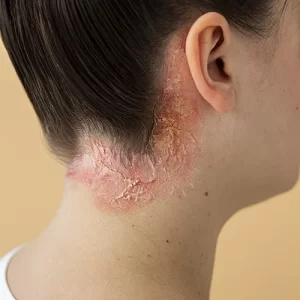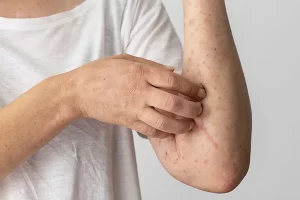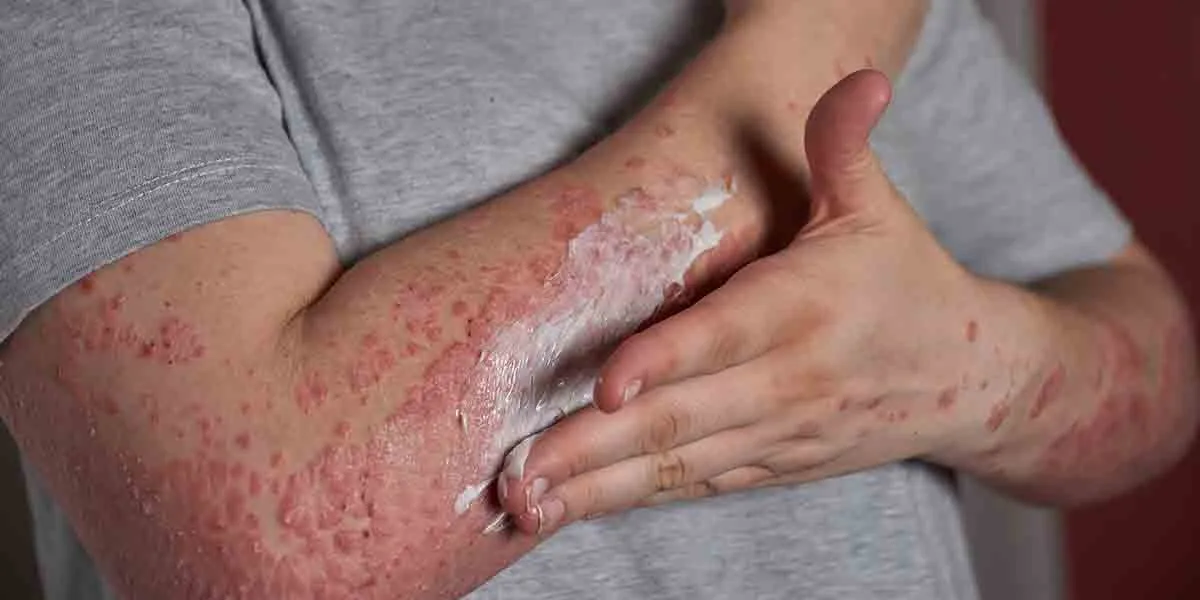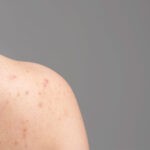A skin allergy is an adverse reaction of the skin to certain substances, often called allergens. These substances can trigger an immune response in some individuals, leading to a variety of symptoms.
Common types of skin allergies include:
Contact Dermatitis: This occurs when the skin comes into direct contact with an irritant or allergen, leading to redness, itching, swelling, and sometimes blisters. Contact dermatitis is a type of skin inflammation that occurs when the skin comes into contact with an irritant or an allergen. It is one of the most common forms of skin allergy. There are two primary types of contact dermatitis: irritant contact dermatitis and allergic contact dermatitis.
- Irritant Contact Dermatitis: This type of dermatitis occurs when the skin’s protective barrier is damaged by exposure to irritating substances. These substances may include harsh chemicals, detergents, solvents, soaps, or even prolonged exposure to water. The skin becomes red, dry, and cracked, and in severe cases, blisters may form.
- Allergic Contact Dermatitis: In allergic contact dermatitis, the skin develops an allergic reaction to a specific substance or allergen. Common allergens include certain metals like nickel (found in jewelry or belt buckles), fragrances, preservatives, cosmetics, latex, and various plant substances like poison ivy, poison oak, or poison sumac. Unlike irritant contact dermatitis, this type of reaction may not occur immediately upon exposure but can take a day or more to manifest.
Symptoms of contact dermatitis may include:
- Redness
- Itching
- Swelling
- Bumps or blisters
- Dry, cracked skin
- Rash or hives
- Oozing or crusting (in severe cases)
Treatment for contact dermatitis often involves avoiding the irritant or allergen that triggered the reaction. Mild cases can often be managed with over-the-counter topical creams or ointments containing hydrocortisone to reduce inflammation and itching. In more severe cases, a healthcare professional may prescribe stronger topical or oral corticosteroids.
To prevent contact dermatitis:
- Use protective clothing or gloves when handling chemicals or substances that could irritate your skin.
- Avoid known allergens or irritants if you are aware of your sensitivities.
- Moisturize your skin regularly to maintain a healthy skin barrier.
If you suspect you have contact dermatitis or any other skin condition, it’s crucial to consult a dermatologist or healthcare professional for an accurate diagnosis and appropriate treatment plan. They can help identify the specific triggers and provide personalized advice for managing and preventing future flare-ups.

Atopic Dermatitis (Eczema): This is a chronic inflammatory skin condition characterized by itchy and inflamed patches of skin. Atopic dermatitis, commonly known as eczema, is a chronic and inflammatory skin condition that affects both children and adults. It is a type of skin allergy that causes the skin to become itchy, red, dry, and sometimes even cracked or leathery. Eczema can vary in severity and may have periods of remission and flare-ups.
Key characteristics of atopic dermatitis include:
- Itchiness: The most common symptom of eczema is intense itching, which can be severe and disruptive, leading to scratching that worsens the condition.
- Red or Inflamed Skin: The affected skin may appear red, swollen, and inflamed, especially during flare-ups.
- Dryness and Scaling: Eczema-prone skin is often dry, rough, and scaly, particularly in areas like the elbows, knees, and hands.
- Weeping or Crusting: In more severe cases or during acute flare-ups, the skin can develop blisters that ooze and crust over.
- Thickened Skin: With chronic eczema, the skin may become thickened, leathery, and darker in color, known as lichenification.
- Frequent Rash: The rash associated with eczema typically occurs in patches and may vary in size and shape.
The exact cause of atopic dermatitis is not fully understood, but it is believed to result from a combination of genetic, environmental, and immune system factors. Individuals with a family history of eczema, asthma, or hay fever are more prone to develop atopic dermatitis.

Treatment for atopic dermatitis aims to relieve symptoms, prevent flare-ups, and improve the quality of life. Some common management strategies include:
- Moisturizing: Regularly applying moisturizers helps maintain the skin’s natural barrier and prevent dryness.
- Avoiding Triggers: Identifying and avoiding triggers that worsen the condition, such as certain soaps, detergents, allergens, or environmental factors.
- Topical Steroids: Corticosteroid creams or ointments can be prescribed to reduce inflammation during flare-ups.
- Topical Calcineurin Inhibitors: Non-steroidal creams or ointments may be used for milder cases or in sensitive areas.
- Antihistamines: These can help alleviate itching, especially at night.
- Wet Wrap Therapy: In severe cases, wet dressings can be applied to soothe and moisturize the skin.
- Phototherapy: Controlled exposure to ultraviolet (UV) light under medical supervision can be effective for some individuals.
For severe and unresponsive cases, systemic treatments like oral immunosuppressive medications may be prescribed.
As always, it’s essential to consult with a healthcare professional, such as a dermatologist, to determine the best treatment plan for your specific condition. They can provide personalized advice and monitor your progress to manage atopic dermatitis effectively.
Urticaria (Hives): Raised, itchy, and sometimes red welts on the skin that can be triggered by various allergens or other factors.
Urticaria, commonly known as hives, is a skin condition characterized by the sudden appearance of raised, itchy welts on the skin. These welts can vary in size and shape and may be surrounded by an area of redness. Hives can appear on any part of the body and often move around, fading in one area while new ones develop elsewhere. They can be acute (short-term) or chronic (long-term) and may last for a few hours or persist for several weeks.
Key features of urticaria (hives) include:
- Raised Welts: The most distinctive sign of hives is the raised, swollen areas on the skin, which are usually pale or reddish in color.
- Itchiness: Hives are often accompanied by intense itching, which can be bothersome and cause discomfort.
- Rapid Onset: Hives typically develop suddenly and may disappear just as quickly, making them unpredictable.
- Changing Patterns: The appearance of hives can change rapidly, with new welts forming and old ones fading away.
- Angioedema: In some cases, hives can be associated with angioedema, which is swelling beneath the skin, particularly around the eyes, lips, hands, feet, or genitalia.
Hives occur due to the release of histamine and other chemicals from mast cells in the skin. Various triggers can lead to this release, including:
- Allergens (e.g., certain foods, medications, insect stings)
- Infections (e.g., viral, bacterial)
- Physical triggers (e.g., pressure, cold, heat, sunlight)
- Emotional stress
- Certain medical conditions (e.g., autoimmune disorders)
Acute hives often resolve on their own without specific treatment. Antihistamines are commonly used to alleviate the itching and reduce the intensity of the hives. In more severe cases or when hives become chronic, a healthcare professional may investigate and address potential underlying causes.
If hives are accompanied by difficulty breathing, dizziness, swelling of the face or throat, or other severe symptoms, it may indicate a more serious allergic reaction called anaphylaxis, which requires immediate medical attention.
If you experience hives or any concerning skin reactions, it’s essential to seek guidance from a healthcare professional, such as a dermatologist or allergist. They can help identify triggers, provide appropriate treatment, and offer advice on managing hives effectively.

Allergic Contact Dermatitis: A specific type of contact dermatitis where the skin reacts to a substance it has become sensitized to over time.
Allergic contact dermatitis is a specific type of contact dermatitis that occurs when the skin comes into direct contact with a substance to which the individual is allergic or sensitized. Unlike irritant contact dermatitis, which is caused by non-allergic skin irritation from harsh substances, allergic contact dermatitis involves an immune system response to the allergen.
Here’s how allergic contact dermatitis typically develops:
- Sensitization: When a person is exposed to an allergen for the first time, the immune system may recognize it as a foreign substance and develop sensitivity to it. This initial exposure does not cause symptoms.
- Subsequent Exposure: When the person comes into contact with the same allergen again, their immune system recognizes it and triggers an allergic reaction. This reaction leads to the development of symptoms on the skin.
Common allergens that can trigger allergic contact dermatitis include:
- Metals (e.g., nickel in jewelry, buckles, or zippers)
- Fragrances (found in perfumes, soaps, lotions, etc.)
- Preservatives (e.g., parabens, formaldehyde)
- Cosmetics (e.g., makeup, hair products)
- Medications (e.g., antibiotics, topical creams)
- Latex (found in gloves, balloons, certain clothing)
- Poison ivy, oak, or sumac (plant allergens)
Symptoms of allergic contact dermatitis can vary in intensity and appearance but typically include:
- Red, itchy rash
- Swelling
- Bumps or blisters
- Dry or scaly skin
- Warmth or tenderness in the affected area
Treatment for allergic contact dermatitis involves:
- Identifying and Avoiding the Allergen: The most crucial step is to identify the specific allergen causing the reaction and avoid further contact with it.
- Topical Corticosteroids: Over-the-counter or prescription corticosteroid creams can help reduce inflammation and relieve itching.
- Emollients: Moisturizing creams or ointments can help soothe the skin and improve its barrier function.
- Oral Antihistamines: These may be used to alleviate itching and help with sleep, especially if the reaction is severe.
- Wet Dressings: In more severe cases, wet dressings may be applied to reduce inflammation and promote healing.
If you suspect you have allergic contact dermatitis, it’s essential to consult a healthcare professional, such as a dermatologist or allergist. They can perform patch testing to identify the specific allergen causing the reaction and provide personalized advice on managing and preventing future allergic responses. Avoiding the allergen is the key to preventing further episodes of allergic contact dermatitis.
Angioedema: Similar to hives, but the swelling occurs beneath the skin, often affecting the face and lips.
Angioedema is a skin condition characterized by deep swelling that occurs beneath the skin’s surface. It involves the swelling of the lower layers of the skin, subcutaneous tissues, and mucous membranes. The swelling is typically painless but can cause discomfort and pressure in the affected area.
Angioedema is different from hives (urticaria) in that it involves swelling beneath the skin, whereas hives are raised, itchy welts on the skin’s surface. However, angioedema can occur alongside hives and may affect areas like the eyes, lips, hands, feet, throat, or genitalia.
There are two primary types of angioedema:
- Allergic Angioedema: This type of angioedema is triggered by an allergic reaction, similar to allergic contact dermatitis or hives. It can be caused by allergens such as certain foods, medications, insect stings, or environmental factors.
- Non-Allergic (Idiopathic) Angioedema: This type of angioedema has no known allergic trigger and is often referred to as idiopathic. It may be linked to other medical conditions, such as certain autoimmune disorders or inherited genetic mutations.
Symptoms of angioedema include:
- Swelling in the deep layers of the skin, typically painless
- Swelling around the eyes and lips
- Swelling of the hands, feet, or genitalia
- Swelling in the throat or airway (in severe cases)
- The skin may appear normal or slightly reddish
In some cases, angioedema can be life-threatening, especially if the swelling affects the throat and restricts the airway. This condition is called “angioedema with anaphylaxis,” and it requires immediate medical attention.
Treatment for angioedema depends on its cause and severity:
- Mild cases may resolve on their own without specific treatment.
- Antihistamines can help reduce allergic reactions and relieve mild symptoms.
- Severe cases may require the use of epinephrine and emergency medical care to manage potential anaphylaxis.
- Non-allergic angioedema may be managed with medications that block certain enzymes involved in the swelling process.
- Identifying and avoiding triggers is essential for preventing future episodes.
If you or someone else is experiencing angioedema with symptoms like difficulty breathing, swelling of the face or throat, or any other severe symptoms, seek immediate medical attention or call emergency services, as this could be a medical emergency. A healthcare professional, such as an allergist or immunologist, can help diagnose the type of angioedema and provide appropriate management and preventive measures.
Common allergens that can trigger skin allergies include certain metals (nickel), fragrances, cosmetics, plants (like poison ivy), latex, certain medications, and certain chemicals.
If you suspect you have a skin allergy, it’s essential to consult a healthcare professional, such as a dermatologist or allergist. They can conduct tests to identify the specific allergens and recommend appropriate treatments or avoidance strategies. In the meantime, you can try to avoid potential triggers and keep your skin moisturized to help alleviate some symptoms.
Please remember that any information provided here is not a substitute for professional medical advice. Always consult a healthcare professional for accurate diagnosis and personalized guidance for your specific situation.
Read these Articles also:
- Turmeric for Acne: The Ultimate Guide to Clear and Glowing Skin
- Tallow for Skin Care: Benefits, Side Effects and How to Use
- Neem Benefits for Skin | Younger Glowing Skin and Hair
- Olive Oil Massage | Benefits and Side Effects for Male and Female
If you don’t like this article/post please share your feedback.





